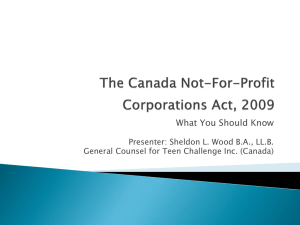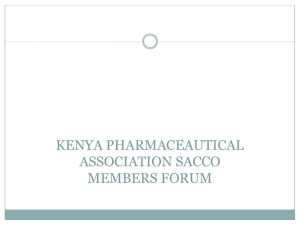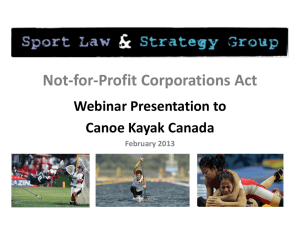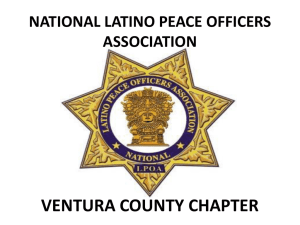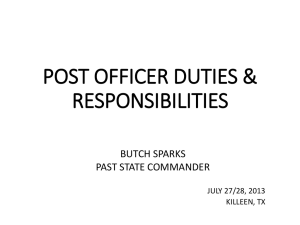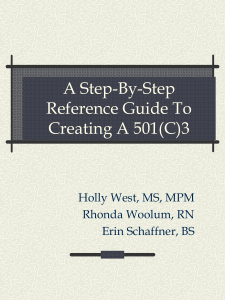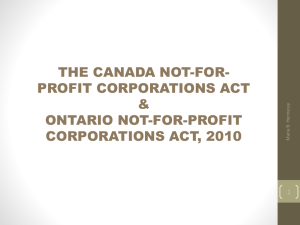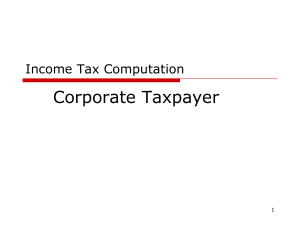Not-For-Profit Workshop - RCMP / GRC Veterans Association des
advertisement
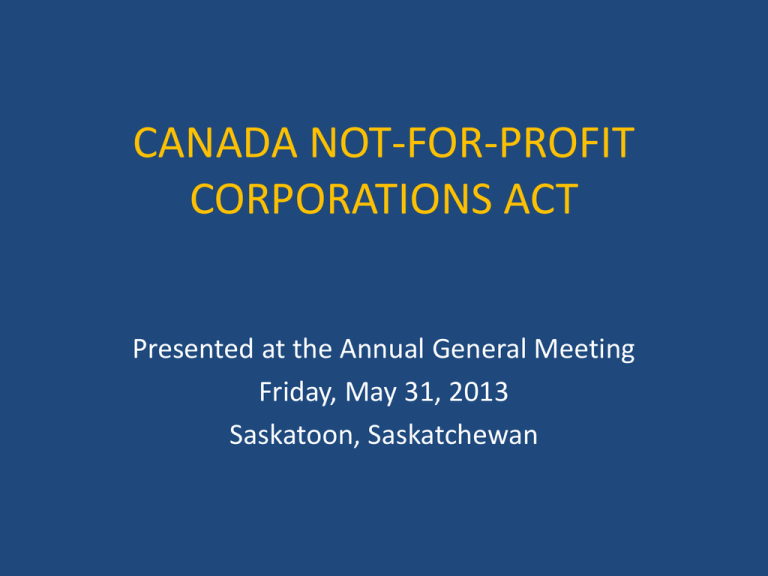
CANADA NOT-FOR-PROFIT CORPORATIONS ACT Presented at the Annual General Meeting Friday, May 31, 2013 Saskatoon, Saskatchewan COMMITTEE Committee Chair • Murray Milne, Director, Saskatoon Division Committee Members • • • • • Dave Leblanc, Vice President, Manitoba Division Ian Atkins, President, Nova Scotia Division Bob Kells, President, Calgary Division Larry Power, Governor, Newfoundland/Labrador Division Jack Briscoe, Executive Director Committee Observers • Cal Small, National President, Ottawa Division • Alex Geddes, National Secretary, Ottawa Division WORKSHOP OBJECTIVES • To work towards obtaining membership approval of draft Articles of Continuance at the 2014 AGM (Ottawa) • To work towards obtaining membership approval of draft by-laws at, or soon after, the 2014 AGM (Ottawa), and • To present the results a National Member Survey THE REASONS WHY • Both the Articles of Continuance and the by-laws had to be created/amended because of new legislation applicable to Federally incorporated not-for-profit corporations. • New legislation is the Canada Not-For-Profit Corporations Act (hereinafter “The Act”) which replaces 1917 legislation: Canada Corporations Act, Part II – Corporations Without Share Capital. • RCMP Veterans’ Association must comply with the new Act and file Articles of Continuance with Corporations Canada on or before October 17, 2014; otherwise we may be deemed to have been dissolved. THE REASON WHY (Con’t)… • The new Act is much more comprehensive in describing powers and obligations than the former Act. It also provides for greater transparency, accountability and good corporate governance. • The new Act also reduces the regulatory burden on affected corporations, such as the Veterans’ Association. Under the old regime, extensive by-laws were required to fill the statutory vacuum. THE REASON WHY (Con’t) • New by-laws are required to be filed with Corporations Canada within one year of their approval by the membership. • Finally, unlike our present by-laws that come into effect only when approved by Corporations Canada, the by-laws under the new Act are effective when they are approved by the membership. Filing the bylaws with Corporations Canada is merely an administrative step. PROCESS GOING FORWARD • Both documents have been drafted and they are available today for review and to take back to your Divisions. • Over the next 6 to 8 months, the Committee will ask for Division input to amend/clarify both of these draft documents. • We would like Division Presidents or Division delegates to identify (1) person for each Division to be the point of contact for all consultations. • Email address will be provided for consultation purposes. PROCESS OUTCOME • Best possible outcome is to make everyone happy with the final products. • In reality, success can be achieved by making happy 2/3 of the members eligible to vote to approve the Articles of Continuance; and • 50% +1 of the members eligible to vote to approve the by-laws. SOME PEOPLE Should Be Made to Stay Home TODAY’S PROCESS • Explain the Articles of Continuance (replaces Letters Patent) to give a flavour of what change might look like. • The Articles is the most time-critical document. Must get member approval by resolution at the 2014 AGM. • Highlight some of the by-laws that will most likely affect you and your Division members most directly. • By-laws are less time-critical although our preference is to also have these approved at the 2014 AGM. ARTICLES OF CONTINUANCE • Form 4031 is a mandatory format. Section 1: Current Name of Corporation Royal Canadian Mounted Police Veterans’ Association/Association des Anciens de la Gendarmerie Royale Du Canada. Section 2: If change of name is requested, indicate proposed corporate name. Not applicable Section 3: Corporate Number 058721-4 ARTICLES OF CONTINUANCE Section 4: Province/Territory in Canada where registered office is located Ontario Section 5: Minimum/maximum number of Directors Minimum 4 – Maximum 11 Section 6: Statement of Purpose of the Corporation To promote and assist in the promotion and advancement of best interests of Canada, especially respect for its Constitution; To be of service to the Government of Canada when required or requested; To co-operate with and render assistance to the police, especially the Royal Canadian Mounted Police, in all matters of common interest or concern; ARTICLES OF CONTINUANCE Section 6: Statement of Purpose (Con’t)…. To promote the physical, social and economic welfare of the Corporation’s members and the members of their immediate families; To establish under such names and titles as may be deemed desirable, such benevolent fund or funds as shall be deemed requisite for the purpose of aiding such former members of the Royal Canadian Mounted Police and the members of their immediate families or their dependents who are in need of assistance and to appoint trustees to supervise the administration and management of such funds; and To provide support to worthy community services and organizations of a charitable or benevolent nature. ARTICLES OF CONTINUANCE Section 7: Restrictions on the activities that corporation may carry on, if any. No restrictions other than what is provided in the Act. Section 8: The classes, or regional or other groups, of members that the corporation is authorized to establish. Membership of the corporation shall be divided into two groups: Voting and Non-Voting members. Categories shall be defined within the by-laws. ARTICLES OF CONTINUANCE Section 9: Statement regarding the distribution of property remaining on liquidation. On liquidation, any property of the corporation remaining after discharge of any liabilities of the corporation, including the corporation’s obligation to return any property a person has transferred to the corporation subject to the condition that it be returned on the dissolution of the corporation, shall be distributed to one or more qualified donees, within the meaning of subsection 248(1) of the Income Tax Act. Section 10: Additional provisions, if any The directors may appoint one or more directors, who shall hold office for a term expiring not later than the close of the next annual general meeting of members, but the total number of directors do appointed may not exceed one-third of the number of directors elected at the previous annual general meeting of members, and for greater certainty, may not exceed the maximum number of directors specified in these Articles. SOME PEOPLE Should Be Made to Stay Home TWO NEW TERMS The new Act introduces two new terms: 1. Soliciting corporation (and its corollary) non-soliciting corporation, and 2. Designated corporation (and its corollary) nondesignated corporation. TWO NEW TERMS (Con’t)… Implications for being categorized as one of the foregoing are very important: • It will determine how the Association must report annually; • how, or whether, the Association must conduct an annual audit, and • whether it must engage a public accountant. TWO NEW TERMS (Con’t)… Important concept: There is only one corporation, comprised of a National Office and 30 Divisions. As the corporation must retain a consolidated annual financial report, then all 30 Divisions must contribute to such a report. If the corporation is subject to a form of audit, a consolidated audit report must include audit reports from all 30 Divisions. If the corporation must engage a public accountant, that public accountant will determine the standard accounting practice all 30 Divisions will be required to comply with (e.g., by a template). TWO NEW TERMS (Con’t)… Soliciting Corporation: Defined in ss. 2(5.1) A corporation that has received in a single financial year income in excess of $10,000 in the form of: Donations or gifts requested from a person who is not a member, director, officer, or employee of the corporation or a family member of such a person Grants or similar financial assistance from the federal government, a provincial or municipal government, or an agency of such a government, or Donations or gifts from another soliciting corporation. A soliciting corporation remains soliciting for 3 years. A WORD ABOUT INCOME • The Association’s annual “income” is income received from all sources, not just that received at the National Office. • Types of money receipts considered income: – – – – membership dues investment income Donations money received from a services contract, etc. • Note 1: It is only that type of income meeting the requirements for soliciting corporation that counts toward the $10,000 threshold. • Note 2: Per capita dues that is received by National Office is not income as it already been accounted for as Association income at the Division level; i.e., no double counting of income. TWO NEW TERMS (Con’t)… • If a corporation does not meet the requirements for a soliciting corporation, it is a non-soliciting corporation. • A designated corporation is a soliciting corporation with annual gross revenues less than $50,000; and a non-soliciting corporation with annual gross revenues less than $1,000,000. • A non-soliciting corporation with gross annual revenues exceeding $1,000,000 is simply referred to a “non-for-profit corporation”. GROSS REVENUE DEFINED • Gross revenue are all monies that flow through the Association bank accounts at the Division level, and at the National level as long as that revenue did not originate at the Division level; i.e., no double counting of revenue. • Examples include: All that is considered income; funds received from such activities as golf tournaments, social events and dinners, sale of inventory items, etc. when members remit fees to their Division, and the event expenses are paid from the Division bank account; [sponsorship funds received]; etc. IMPLICATIONS FOR AUDITS Type of Corporation Gross Annual Revenues No Review Review Engagement Audit Soliciting Less than $50k Optional Default Optional Soliciting Between $50 and $250K Not Possible Optional Default Soliciting More than $250k Not Possible Not Possible Mandatory Non-Soliciting Less than $1 million Optional Default Optional Non-Soliciting More than $1 million Not Possible Not Possible Mandatory Where the choice of review/audit is “optional”, that option is chosen by way of a by-law. IMPLICATIONS FOR FINANCIAL RECORDS A soliciting corporation must send a copy of its comparative annual consolidated financial statement to the Director (Corporations Canada Official) not less than 21 days before the corporation’s AGM. (ss. 176(1)). All corporations must furnish a copy of these same financial statements to the Director upon request. (s. 177) These same financial statements must be made available, upon request, to members of the corporation, at the corporation’s registered office during normal business hours. (ss. 174(2)) PUBLIC ACCOUNTANT S. 181(1): Subject to section 182, members of the corporation shall, by ordinary resolution [50% +1], at each annual meeting, appoint a public accountant to hold office until the close of the next annual meeting. S. 182(1): Members of a designated corporation may resolve not to appoint a public accountant, but the resolution is not valid unless all the members entitled to vote at an annual meeting of members consent to the resolution. S. 182(2): The resolution is valid until the following annual meeting of members. CORPORATE RECORDS A corporation shall prepare and maintain at its registered office: a) the Articles of Continuance and the By-laws; b) the minutes of meetings; c) the resolutions of members; d) any debt obligations in prescribed format; e) a register of directors in prescribed format; f) a register of officers in prescribed format, and g) a register of members in prescribed format. “in prescribed format” includes: name; residential address; email address if the director, officer or member consented to receive information and documents by electronic means; the date the director, officer or member became, and/or ceased to become, a director, officer or member; and for the member registry, the class or group of membership. Each registry must be capable of being rendered in alphabetical order and in print format. SOME PEOPLE Should Be Made to Stay Home BREAK TIME BY-LAWS • There are two mandatory by-laws: 1. A by-law setting out the conditions of membership is required by section 154. 2. A by-law setting out the requirements for meetings of members (Annual General Meeting/Special Meeting) is required by subsection 162(1). BY-LAWS (CON’T)… • All other by-laws have but one purpose - - to vary the “default” position of a section of the Act when the Act invites it, and when the default position is deemed not be appropriate to meet the needs of the Association. • Example #1: s.143(1): Subject to the Articles, the by-laws and any unanimous member agreement, the directors of a corporation may fix the reasonable remuneration of the directors, officers and employees of the corporation. • Example #2: ss. 126(2): Unless the by-laws otherwise provide, a director of a corporation is not required to be a member of the corporation. BY-LAWS (CON’T)… • But, if the default position is deemed appropriate, or there is no invitation to vary the position, then what’s in the Act prevails. Implications o With the comprehensive legislation, and the by-laws only to vary the default positions, members and particularly members of the Executive at the National level (and to a lesser extent at the Division level) will have to become familiar with the Act, the Regulations and the by-laws. o The Regulations contain only the “prescribed” detail. o In the past, members could adequately cope with Association business by being familiar with only the by-laws. BY-LAWS (CON’T)… o The intention is have one set of by-laws. By-laws are a level of statutory authority and they are written pursuant to an authority given by the Act. o By-laws will be supplemented by a National Operations Manual for Association policy and procedures. o By-laws and the Operations Manual will be supplemented by Division Procedures Manuals governing each Division’s policy, procedures and activities at the local level. BY-LAWS (CON’T)… o The new Act authorizes the corporation directors to amend the by-laws. This is a default position. o However, a by-law has been drafted varying the default and retaining the current practice that requires amendments to be approved by the membership before they have force and effect. BY-LAWS (CON’T)… o Mandatory By-law #1: Conditions of Membership o Two classes or groups: Voting and Non-Voting o Numerous categories within each class (or group) Voting Active and Life Members Non-Voting Transitional, Associate, Honourary, Honourary Life, Honourary Officer, Honourary President, Patron and Provincial Patron. MEMBERSHIP DUES o S.30 Subject to the Articles, the By-laws and any unanimous member agreement, the directors may require members to make an annual contribution or pay annual dues and may determine the manner in which the contribution is to be made or the dues are to be paid. o By-Law V11 (1) The annual dues payable by Active Members and Life Members shall be those fixed on annual basis by the Board. The Board shall authorize Divisions to assess additional annual contributions from those members of the Association within their Division as they see fit. MEETING OF MEMBERS (AGM) o Mandatory By-law #2: Meetings of Members •Refers only to National Meetings (AGM/Special); •Must be held annually within 3 months of previous AGM, but no later than 6 months after close of preceding financial year; •Must be held in Canada; •By-laws prohibit electronic meetings of members; •Notice of meeting process is exacting and all time lines are prescribed •4 possible methods: 1. By post mail, courier or personal delivery 2. By telephonic or electronic communications 3. By affixing a notice on a Notice Board 4. By publication in a newspaper or Association publication MEETING OF MEMBERS (AGM) • The Directors may fix a record date, that being 21 to 60 days before the date of the meeting to: • determine the members entitled to receive a Notice of Meeting • determine the members entitled to vote at a Meeting of Members • However, if no record date is fixed by the Directors: • determining the members entitled to receive a Notice of Meeting • determining the members entitled to vote is the close of the business day preceding the day the Notice is given. • If no Notice is given, the determination is made as at day of the meeting. VOTING • THE CURRENT PROCESS o Members in attendance vote o Division delegates serves as proxy holders for all other Division members and votes the number of members entitled to vote en bloc, minus those members in attendance. • THE NEW PROCESS o Only those in attendance can vote, or, in addition o Absentee voting can be authorized by By-law, but must be one or more of the following: by proxy by mail in ballot by electronic means VOTING o Detail around available voting procedure in the NFP Regulations. o Attendance-only voting was deemed un-democratic and too radical a departure from current practice. o By-laws authorize absentee voting plus in-attendance voting. o Voting by mail in ballot and by electronic means requires potentially expensive procedures, as confidentiality in voting is required. o Therefore, proxy voting is seen as the most viable absentee voting process – but must follow prescribed procedures. PROXY VOTING o Every member entitled to vote will receive a proxy form containing a list of candidates to be elected, and resolutions to be voted on. o If not attending the meeting, members who are entitled to vote can assign their votes to a proxy holder who will be attending the meeting. o Absentee voters thereby become eligible to cast a vote. o The member will indicate on the proxy form their voting choices for candidates and for resolutions. o The proxy holder will attend the meeting and vote according to the instructions on each proxy form. o Processes have been developed to distribute and collect proxy forms, to validate proxies and proxy holders, and the method to tally votes at an AGM. The detail will be in Operations Manual. DIRECTORS AND OFFICERS o CURRENT o Members elect officers and directors at AGM o All comprise the Board of Directors o President chairs the Board o NEW PROCESS o Distinguishes directors and officers o Directed must be elected by members o Officers appointed by directors o Directors may also be officers o Officers may attend Board meetings (by right if by-laws provide for it) but cannot vote o Ex officio directors are prohibited MISCELLANEOUS o Useful terms Ordinary resolution means 50% + 1 of votes cast Special resolution means not less than 2/3 of the votes cast. o Not-For-Profit Corporations Act available at: http://laws.justice.gc.ca/eng/acts/C-7.75/FullText.html o Regulations available at: http://laws-lois.justice.gc.ca/eng/regulations/SOR-2011-223/index.html o Consultation contact at: rcmpvetsconsult@yahoo.ca SOME PEOPLE Should Be Made to Stay Home BREAK TIME SURVEY SAYS…. The motivation to conduct a National Member Survey is derived from the mandate given to the Executive Director from the Chair, National Operations Committee on behalf of the Board of Directors, to identify the strengths, weaknesses and opportunities to streamline and improve the overall management of the National Office and, to provide advice whether the current governance structure is the most effective model for the future of the Association. The results from the survey, when considered in the context of the Canada Not-For-Profit Corporations Act, are very instructive and provide the motivation to examine options for a more effective governance structure. Leadership is a choice, not a position. SURVEY SAYS…. On-line, confidential, bilingual survey was produced and disseminated to all 30 Division Presidents for distribution to all Active and Life Members. The survey was available for 30 days, closing at midnight March 10, 2013. The survey was also made available in hard copy for any member who requested it in that form. The data was collected by the National Office only and no person was identified and no attribution was made. SURVEY SAYS…. Overall Results: The survey was opened 2,732 times in 30 days. 773 responses were received, including hard copies. Represents 18% of the total population of 4,691 Active and Life Members. SURVEY SAYS…. What we asked, what we got and what we did with it.. Twelve 12 questions were asked related to the roles, responsibilities of the National Office, the quality of our national communications, the effectiveness of the Board of Directors, motivation to join the Association and finances. Twenty-six (26) pages of candid, narrative comments were provided by the respondents. A summary report has been provided to the Board and to the Committee members to assist in our deliberations. SURVEY SAYS…. Question 1,2 and 3: The National Office Cost to maintain a National Office Level of awareness about work of National Office Services most valued by members Statistical Summary 72% of respondents support maintaining a National Office 68% said they were somewhat informed 78% said advocacy and communications most valued SURVEY SAYS…. Summary of Narrative Comments With notable exception, the majority of respondents identified a lack of awareness of roles, responsibilities and activities of the National Office in order to make an informed judgment on the value added of maintaining a national office funded by membership per capita dues. Advocacy and communications were seen to be the most valued services. SURVEY SAYS…. Question 4,5,6 – Communications Quality, content and value of national communications Frequency of access to National website Effectiveness of National website Statistical Summary 60% of respondents said they were fully satisfied 50% access the national website frequently 74% believe it is an effective platform SURVEY SAYS…. Summary of Narrative Comments The majority of respondents believe that National needs to communicate more effectively with the membership. While it was acknowledged that communication from National to Divisions on a wide variety of issues is being frequently disseminated, respondents felt these messages were oftentimes too bureaucratic, sometimes lack clarity and too content heavy; more executive summaries would be appreciated. In this regard, Division communications were generally more valued than National information. Respondents felt the national website needs to be upgraded and better coordination was required between division and national websites, including ease of access, currency of information and search capacity. SURVEY SAYS…. Question 7,8,9 - Board of Directors Level of awareness of Board functions Need for strategic planning by Board Effectiveness of the Board of Directors Statistical Summary 63% are somewhat aware of the Board’s functions 71% believe a strategic plan for future is needed 58% believe the Board is somewhat effective. SURVEY SAYS…. Summary of Narrative Comments Respondents felt there is a lack of understanding of the roles and responsibilities and activities of the Board of Directors. Moreover, they expressed the opinion that divisions are not always consulted and more interaction with divisions is necessary. While respondents generally appreciated the volunteer work of their elected directors, they would like to see more proactive participation between the Board and the membership particularly on matters of advocacy and lobbying efforts on member benefits. Board relevance and a perception the Board is somewhat detached from the membership is particularly noteworthy. SURVEY SAYS…. Question 10: Finance Alternatives to membership dues Statistical Summary 61% agree revenue options should be explored 39% either somewhat agree or completely disagree SURVEY SAYS…. Summary of Narrative Comments There is minimum support for exploring alternatives to funding National operations rather than a reliance on membership dues, however some respondents feel that if the membership values the role of an Association National Office, then we should fund it from within. SURVEY SAYS… Question 11: Reason for Joining Vets’ Association Statistical Summary • • • • • 80% said to stay connected to the RCMP 50% said for the fellowship 33% said to assist members in retirement 23% said for community involvement 20% said for social activities and fraternity SURVEY SAYS… Question 12: Per Capita Increase $10 $15 $20 $25 Statistical Summary • • • • 60% supported $10.00 17% supported $15.00 14% supported $20.00 10% supported $25.00 SURVEY SAYS… TO EVERYONE WHO PARTICIPATED, THANK YOU! GOVERNANCE The Canada Not-For-Profit Corporations Act creates an opportunity for the RCMP Veterans’ Association to revise our governance regime to better serve the needs of the membership. At present, a not-for-profit corporation can avoid giving significant rights to members, leaving the Board with relative autonomy to run the business and affairs of the corporation. Under the new Act however, and the not-for-profit legislative regime, members will have significantly enhanced, and unalterable, rights and remedies. These rights will have an effect on the autonomy of the Board and will change how the Board and the corporation interact with members. NEXT STEPS Given the feedback from the survey relative to our strengths, weaknesses and opportunities for improvement, and because the Act provides an opportunity to explore new models to enhance our effectiveness, the Committee welcome the active participation of the Division representatives to work with us to design governance options to be presented to the membership at the 2014 AGM in Ottawa. THE END! Your present circumstances don’t determine where you can go, they merely determine where you start. Nido Qubein
